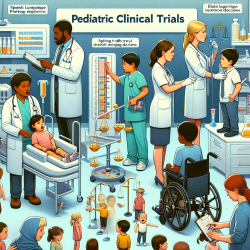Introduction
In the realm of speech-language pathology, the quest for understanding the intricate workings of the brain is unending. Recent research, particularly the study titled Brain gray matter network organization in psychotic disorders, offers groundbreaking insights that can significantly enhance our approach to therapy, especially for children. This study not only highlights the neural discrepancies in psychotic disorders but also provides a framework for understanding familial risk factors, which can be pivotal in tailoring therapeutic interventions.
Key Findings of the Study
The research conducted by Zhang et al. (2020) delves into the structural organization of brain gray matter in individuals with psychotic disorders. The study involved 326 probands with psychotic disorders, their 315 nonpsychotic first-degree relatives, and 202 healthy controls. Using advanced MRI techniques, the study revealed:
- Decreased nodal efficiency in the bilateral superior temporal regions of psychotic probands, indicating a reduced capacity for information processing.
- Altered morphological relationships primarily with frontal lobe regions, associated with positive symptoms of psychosis.
- Nonpsychotic relatives exhibited lower nodal centrality in the prefrontal cortex and subcortical regions, suggesting potential familial risk markers.
Implications for Practitioners
For practitioners working with children, these findings underscore the importance of early detection and intervention. Understanding the structural and functional brain differences can guide the development of targeted therapies that address specific cognitive deficits. Here’s how practitioners can leverage these insights:
- Early Screening: Implement screening tools that assess cognitive and language development, particularly in children with a family history of psychotic disorders.
- Customized Therapy Plans: Develop individualized therapy plans that focus on enhancing nodal efficiency in critical brain regions, such as the superior temporal and frontal lobes.
- Parental Involvement: Educate parents about the potential familial risks and involve them in the therapeutic process to support their child’s development effectively.
Encouraging Further Research
While the study provides significant insights, it also opens avenues for further research. Practitioners are encouraged to explore the following areas:
- Longitudinal Studies: Conduct longitudinal studies to track the developmental trajectory of children at risk and the impact of early interventions.
- Multimodal Approaches: Integrate multimodal imaging techniques to gain a comprehensive understanding of brain network alterations.
- Cross-Disciplinary Collaboration: Collaborate with neuroscientists and psychologists to develop holistic intervention strategies.
Conclusion
The study on brain gray matter network organization in psychotic disorders offers valuable insights that can revolutionize therapeutic approaches in speech-language pathology. By understanding the neural underpinnings of psychotic disorders, practitioners can enhance their skills and create better outcomes for children. For those interested in delving deeper into this research, I highly recommend reading the original research paper here.










